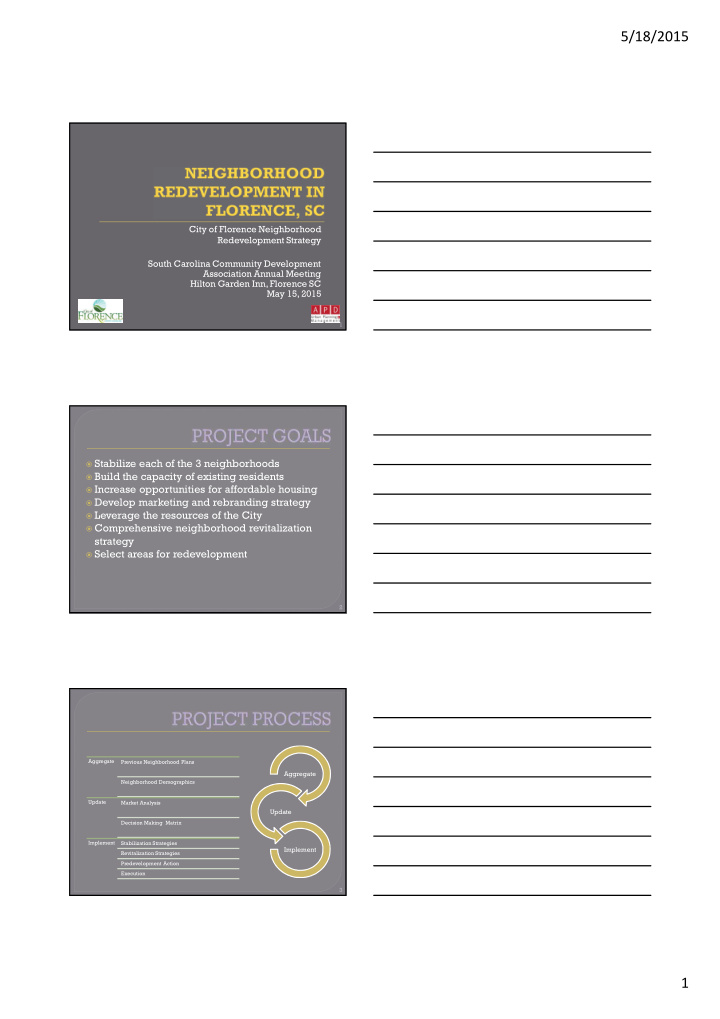



5/18/2015 City of Florence Neighborhood Redevelopment Strategy South Carolina Community Development Association Annual Meeting Hilton Garden Inn,Florence SC May 15,2015 1 Stabilize each of the 3 neighborhoods Build the capacity of existing residents Increase opportunities for affordable housing Develop marketing and rebranding strategy Leverage the resources of the City Comprehensive neighborhood revitalization strategy Select areas for redevelopment 2 Aggregate Previous Neighborhood Plans Aggregate Neighborhood Demographics Update Market Analysis Update Decision Making Matrix Implement Stabilization Strategies Implement Revitalization Strategies Predevelopment Action Execution 3 1
5/18/2015 Decision Making Matrix Purpose – strategically select areas for stabilization and revitalization strategies Site visits, existing conditions,and market analysis dictate locations Decision Making Matrix recommends approaches for selected areas based on developed criteria Use of maps to demonstrate how different criteria factor into prioritizing proposed housing development strategies and approaches 4 Decision Making Matrix Results Florence Catalytic Project Areas - Revitalization Criteria Infrastructure Proximity to Transit Stops Proximity to Proximity to Open Space Proximity to Involvement Proximity to Ownership Investment Access to Education Corridors Ability to Property of Local Partners Funded Projects Market Future Food Total Project Area 1E+2E 0 0 0 10 0 0 1 0 0 0 11 Project Area 3E 5 0 0 0 5 0 9 0 0 7 26 Project Area 1N 0 0 0 0 0 0 8 0 0 0 8 Project Area 2N 5 0 0 5 0 5 10 5 6 0 36 Project Area 3N 5 0 0 10 0 5 2 5 0 0 27 Project Area 4N 0 5 0 10 10 0 3 5 0 7 40 Project Area 5N 0 5 0 10 5 0 7 5 6 7 45 Project Area 1NW 5 0 0 5 0 0 5 5 0 0 20 Project Area 2NW 5 5 0 0 0 10 4 5 0 7 36 Project Area 3NW 5 0 0 5 5 10 6 5 0 0 36 5 Market conditions that drove the selection of project areas. • Residential Development Lack of ownership units to meet demand of existing moderate to middle income households (80% of AMI and above) New and rehab units can capitalize on the proximity to downtown employment Poor condition of housing in affordable range does not meet modern living needs • Retail Market Little retail has occurred or currently exist in the Project Area Neighborhoods There is sufficient demand for additional retail goods and services Within Project Area Neighborhoods, future development will most likely occur along major traffic corridors 6 2
5/18/2015 7 Each catalytic site includes: • Rational for selection • Program and Market • Urban Design Recommendations • Infrastructure Assessment • Streetscape Recommendations • Financial proforma • Estimated Project Budget 8 Stabilization Revitalization Predevelopment Execution Strategies Strategies Process • Catalytic Projects • Safety • Single Family • Project Management • Project Phasing Residential Team • Code Enforcement • Financial Modeling Development • Rental Property • Land Assembly, • RFQ & RFP Registration • Economic Property Acquisition • Proposed Timeline Development and Property • Existing • Funding Sources Strategy Management Residents/Business • Property • Rezoning and Programs Conveyance Design Guidelines • Protection of • Marketing and Historical Assets Branding 9 3
5/18/2015 Authorizations to Purchase Willing Sellers Purchase Approvals Property Closing 10 11 Single Family Owner Residential and Mortgage Occupied Retail Façade Assistance Rehabilitation Loans Program Loans Rental Developer Single Family Rehabilitation Second Builder Loans Loans Mortgage Loans 12 4
5/18/2015 Augusta’s Laney Walker/ Bethlehem HOME LISTINGS 13 14 15 5
5/18/2015 16 17 6
Recommend
More recommend